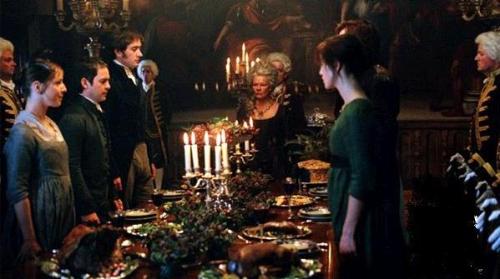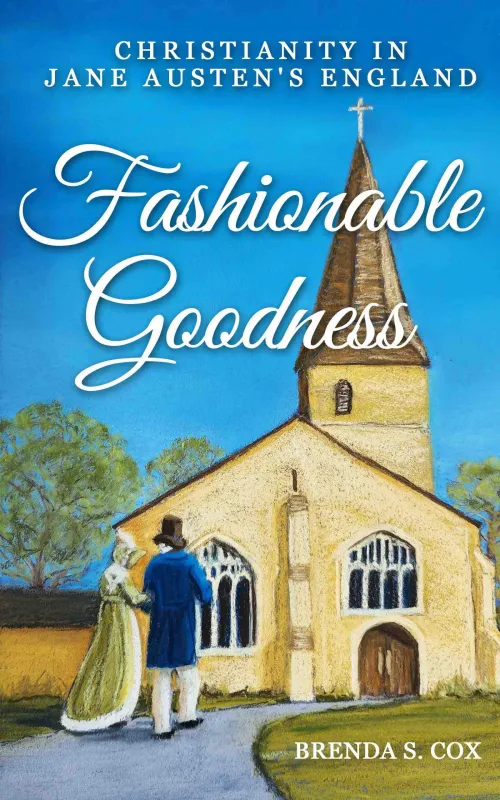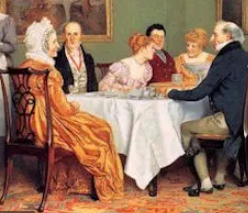In Part 1 of this series, we learned about the “morning” portion of a Regency woman’s day including pre-breakfast activities, breakfast foods and drinks, social calls, midday refreshments, and dressing for dinner. Now, we’ll explore the evening portion.
Evening: As we said last time, the typical Regency day consisted of two parts: “morning” and “evening.” Evenings were marked by changing clothes for dinner. For Jane Austen and the heroines in her novels, evenings varied greatly depending on where they were and who they were with. Evenings at home were usually quiet and modest; the Austen family enjoyed reading and talking together in the evening when they were home. Evenings out in company were lively and filled with dinners, games, and dances.
Dinner: Dinner was the largest and most formal meal of the day for people of Austen’s day and proper etiquette was essential. The timing of dinner moved later during Austen’s life, settling at six or seven. It was considered fashionable to delay dinner. The later the meal, the more candles needed; thus, affluent families could afford later dinners.
In company and at home, evening attire was more formal than day wear. Dinners at home tended to be more simple, with one course instead of two. This is undoubtedly when young girls learned proper mealtime etiquette from their mothers. For dinners in company, the food was as “lavish as the host’s budget allowed” (All Things Austen 147).
When dinner was served in company, guests walked into the dining room in couples, with the rank of the ladies determining the order in which they entered: “Where rank was equal, married women went before single women, and older ladies took precedence” (133). Once in the dining room, the hostess sat at the top of the table, the host at the bottom. The “pre-eminent male guest was seated on the hostess’ right hand, the chief female guest at the host’s right” (134).

Dinner with Lady Catherine de Bourgh: Pride and Prejudice, 2005.
Dinner Courses: The first course was comprised of a variety of dishes including joints of meat and boiled or roasted fowl. There was always soup and very often a whole fish. When these were removed, the second course was brought out. For the second course, the same amount of dishes were served, with new meat perhaps, but “the emphasis this time round was on the lighter savoury concoctions like fricassees and patties, together with a selection of fruit tarts, jellies and cream puddings” (43).
Two courses were served in grand households every day and in ordinary households when there was company. We see this in Pride and Prejudice: “Mrs. Bennet had been strongly inclined to ask [Mr. Bingley and Mr. Darcy] to stay and dine;” however, though she always “kept a very good table, she did not think anything less than two courses could be good enough for a man on whom she had such anxious designs, or satisfy the appetite and pride of one who had ten thousand a year.” (PP)
After the second course was removed, the cloth was cleared and dessert was brought out. Dessert was usually served with wine and included “tidbits which could be eaten using the fingers” such as “dried fruits, nuts and sweet and spicy confections.” (ATA)
Interestingly, food was not passed around the table as we might do today. Men helped women to the dishes within reach, but servants did not take dishes around the table to serve each guest (as we might see, for example, in Downton Abbey). Sometimes a popular dish might be duplicated on both ends of the table but not always.
After dinner: At home, people often took walks and spent their time after dinner less formally. However, in company, the ladies retired after dinner to the drawing room, again in order of rank. The men stayed behind to drink port and talk uninhibited.
“If this was the hour most looked forward to by many of the men, it could be the most tedious hour for the women, thrown on their own resources in the drawing-room, with neither alcohol nor male company to inspirit the scene.”
-Maggie Lane, Jane Austen and Food
We certainly see this occur in Lady Catherine De Bourgh’s drawing room: “When the ladies returned to the drawing room, there was little to be done but to hear Lady Catherine talk, which she did without any intermissions till coffee came in” (PP).
Tea: Tea was taken once the men rejoined the women. The ladies poured coffee and tea, and usually some light refreshment was given, such as cake or toast. Men would approach the women for a cup, which often allowed conversations to spark. It’s not surprising that everyone looked forward to this portion of the evening, especially unmarried people.
Evening Entertainment: After tea, at home and in company, men and women spent the evening together. At home, they might read out loud, play the piano, sew, write letters, or read. At Netherfield when Elizabeth is staying to care for Jane, many important scenes and conversations occur in the drawing room after dinner. Mr. Darcy uses that time to write to his sister and read books, while Miss Bingley uses her time trying to get his attention.
In company, music was often performed, as we see in Emma and Sense and Sensibility with playing and singing. In Mansfield Park, Mary Crawford plays the harp. Cards and games like whist and lottery were also enjoyed by all once the tea table was cleared. At a private ball or at a large enough party in a home, there was usually dancing.
Supper: If a woman’s stays weren’t already about to burst after several courses of dinner, dessert, and tea time, there was supper to look forward to at the end of the evening. At home and in small gatherings, it was a simple meal laid on a smaller table in the drawing room where everyone was gathered. At a ball or larger gathering, supper was a much more substantial meal and must include soup.
Austen herself was known for staying out until the wee hours of the morning after a dance or party, which is why Regency women often slept later in the morning. When they arrived home, women retreated to their rooms. What a relief it must have been, after a long evening of eating, dancing, and socializing, to take down one’s hair, change out of one’s dress, petticoats, and stays, and slip into bed.
This is just a sample of the way Jane Austen’s Regency women might spend their evenings. Next month, we’ll look more closely at women’s issues of the time, such as female education and accomplishments, hygiene and beauty, fashion and cosmetics, and pregnancy and childbirth.
Food for thought: If you could spend an evening with Jane Austen, what activities would you most like to do?
Rachel Dodge is the author of Praying with Jane: 31 Days Through the Prayers of Jane Austen (2018) and The Anne of Green Gables Devotional: A Chapter-By-Chapter Companion for Kindred Spirits (November 2020). Rachel teaches college English classes, gives talks at libraries, teas, and book clubs, and writes for Jane Austen‘s World blog and Jane Austen‘s Regency World magazine. You can visit her at RachelDodge.com.








that was a d’oh! moment – dining later being for conspicuous consumption. It had somehow passed me by to figure that out.
What a wonderful account of the meals and related entertainment.
I would want to spend time together during the post-dinner tea time.
denise
I would like to spend the evening with Jane Austen doing some needlework, especially quilting.
… perhaps whilst Jane reads her day’s work?
Very interesting. I wonder if enough veggies and fruit were available for a healthy diet. Of course, seasonal scarcity was likely a factor, unless there was a greenhouse.
I would have enjoyed a rough ramble with Jane, such as Elizabeth took on her way to see Jane when she was sick at Netherfield. Jane could dish all the neighbors and recount their dubious escapades in a very entertaining way.
Leslie, there are 18th c. recipes for quinces and preserves for those who could afford expensive sugar. Honey was gathered, fruit was dried. Apples from orchards were stored, and vegetables were pickled. The choice was narrow, but, except for the very poor, the gentry, pseudo gentry, and middle class had access to some fruits and vegetables to tide them over the winter.
Hello,
What a fabulous article. I have only recently discovered your site and it is quite an eye opener. As a ghost writer, it has already served me well in my research, however, I have a question about a recent assignment that I am struggling to find the answer to.
My Capt, who will inherit the Dukedom as his brother has passed away, is apparently going to lose his home as his older brother mortgaged the house, so he now must marry well and provide an heir etc.
In the link – ‘Addressing the Duke and Inheriting his Loot,’ it appears, that lawfully this cannot happen. It states that a Duke’s property cannot be removed from the title.
I would love some advice as to whether there were extenuating circumstances, as I would need to inform my client that their premise of ‘tragedy’ would need updating.
Many thanks for your time.
I think the link you reference just means that the current Duke really is just a life tenant essentially and cannot legally dispose of the property. However, the income that is inherited with the title, necessary to maintain and run the house, can be lost (through gambling, unwise investments, etc.), which would necessitate finding a wealthy heiress (often American during the Gilded Age). Despoiling the estate’s financial footing was such a common theme in literature, whether done by devious guardians during the minority of the heir/heiress, or by debauched living and gambling (Tom Bertram in Mansfield Park), or by ineptitude and overspending (Mr. Bennet, P&P, Walter Elliot, Persuasion), that it made retrenchment necessary, and propelled the plot.
Dear Leslie,
Thank you for your invaluable information. This would make more sense. It seems a vague subject and I was worried I would be writing an unlikely scenario.
Time invested in writing and sourcing, that I did not want to waste.
Many thanks your your reply.
Not being a Regency inheritance law expert (only an opinionated bookworm), I googled Regency inheritance law, wills, devises and entails, and Courtney Milan has some very apropos info on your topic. I’m sure you would find it interesting. The basic idea is that it depends on the original land grant from the king, and how he gifted the land and title, including whatever limitations were imposed. I do not want to think of you toiling away at your keyboard and having to do revisions demanded by a nitpicky editor🙄 , relying on my questionable deductions from novels😱. Happy writing!